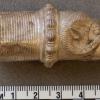Karaburun Tumulus II, early 5th century BC.
Tumulus II at Karaburun (Lycia) dates to the early 5th century BC and is remarkable for its painted frescoes, which depict scenes of dining, warfare, and procession. See Mellink's article(1971) on the 1970 excavations for a lively description of the painted decoration and also for some black and white images of the painted walls. The colour images shown here come from Stella G. Miller, 'Two painted chamber tombs of northern Lycia, in L. Summerer and von Kienlin, Tatarlı: Renklerin Dönüsü (2010), 318-329). The frescoes have subsequently been stolen.
The tomb chamber measures 3.00x2.61m, with a gabled roof 2.66m high. The main west wall depicts a reclining dignitary dressed in a wide-sleeved Persian garment with rosette border, wearing Persian-style jewellery. A female figure stands behind him at right (see image above), holding an alabastron and a fillet. Two servants are seen at left, wearing tightly-fitting Persian-style clothing and carrying high-status objects with strong Persian associations, including a jug and a fan with a ram's head terminal (cf. BSH18). The north wall depicts a battle scene between a warrior on horseback in Persian dress, looming over a fallen Greek hoplite (illustrated here), in a rather similar scene to that depicted on the Çan sarcophagus.

![Image for Çan Sarcophagus, 1st quarter of 4th century BC. [View 1]](https://www.cabinet.ox.ac.uk/sites/default/files/styles/thumbnail__small/public/images/sources/10506987054_112a460859_o.jpg?itok=8qmfo06R)
